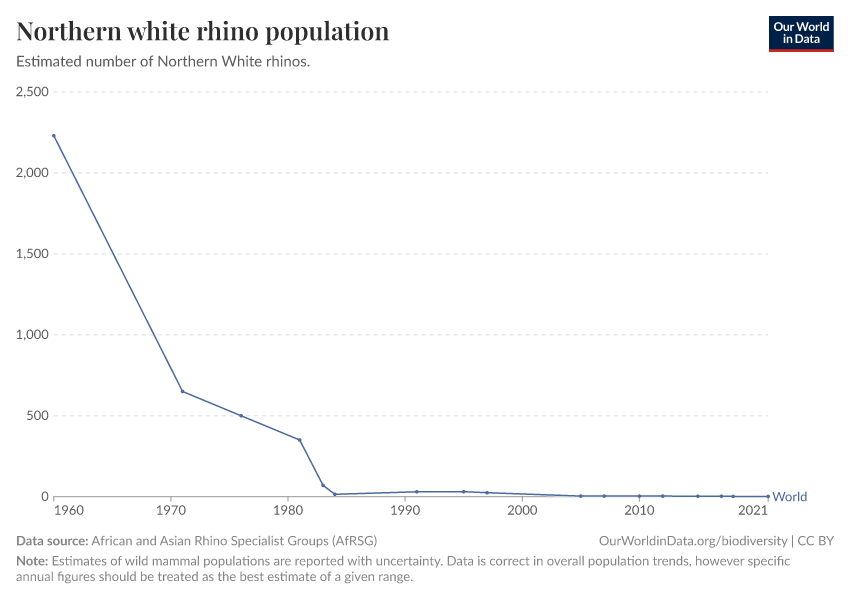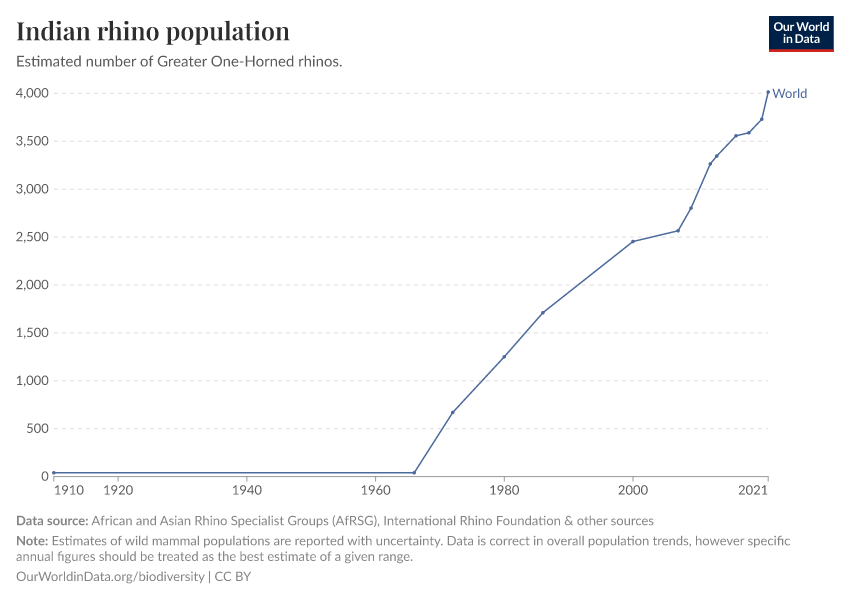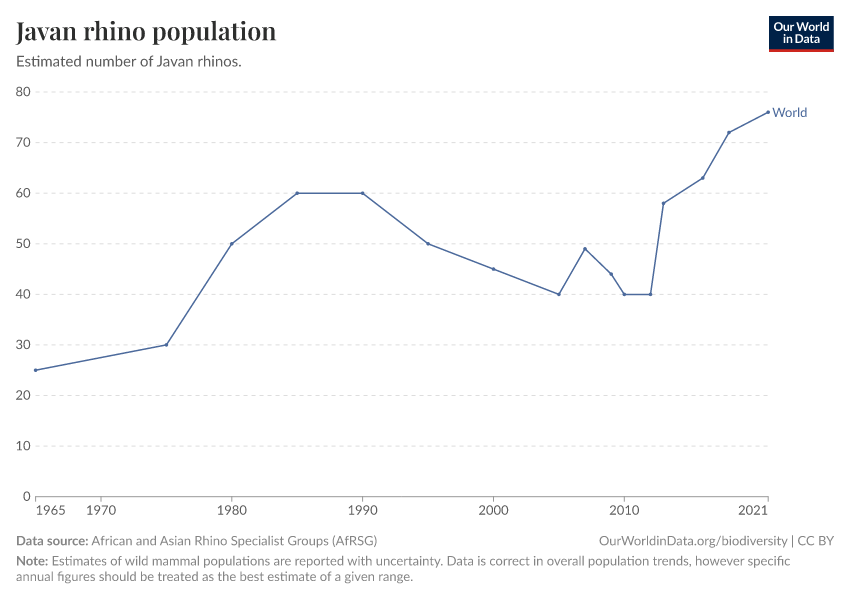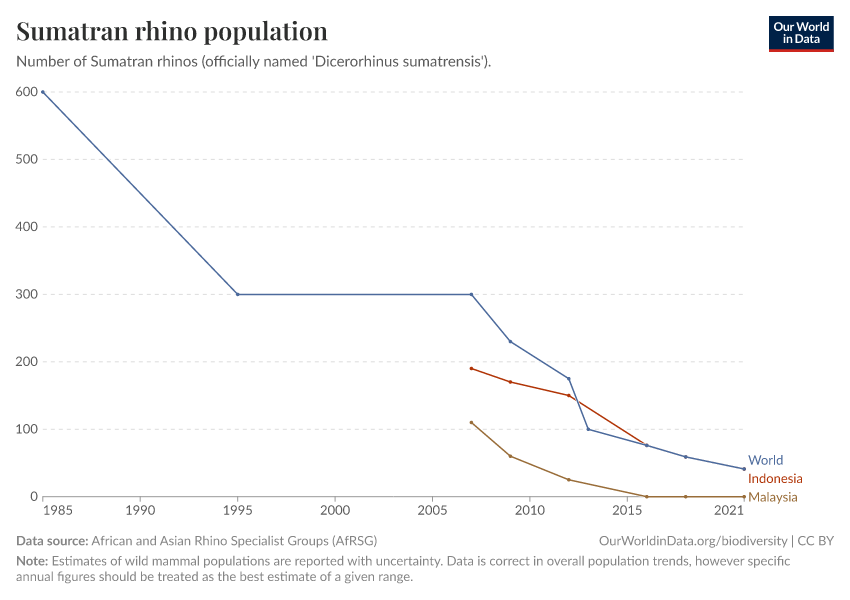The state of the world's rhino populations
How have rhino populations changed over time? What species are at risk of extinction today?
The largest mammals are at the greatest risk of extinction. This has been the case since the arrival of humans, and is still true today.
Weighing in at several tonnes, rhinos are some of the world’s largest mammals.1 With extravagant prices for rhino horns and body parts, they’re also one of the most threatened: three of the five rhino species are ‘critically endangered’.
In this article we take a look at the status of rhino populations today, and whether they are in decline or on the path to recovery. They offer us both stories of concern and reasons for optimism.
State of rhino populations today
There are five species of rhino. Africa is home to the White and Black Rhino. The remaining three – the Sumatran, Javan and Indian – exist in Asia.
Some of these species have dangerously low population levels.
The Sumatran and the Javan Rhino can now only be found in Indonesia. They are Critically Endangered with less than 100 individuals left in the wild. The Black Rhino, despite having a population in the thousands, is also Critically Endangered. It experienced a rapid decline over the 20th century as we will see later.
The Indian (Greater One-Horned) offers us an important success story; it has seen a significant recovery in recent decades. The White Rhino too has shown an impressive recovery. But it has a dark side: the Southern White Rhino might be doing well but the Northern sub-species is on the brink of extinction. There are only two Northern White Rhinos left, and both of them are female.
Are rhino populations increasing or decreasing?
The health of these rhino populations is not just determined by how many animals are left today. The direction and pace that these populations are changing matters too.
For each species I have built a time-series of populations globally and by country. This data is aggregated from multiple sources: the main one being the African and Asian Rhino Specialist Groups (AfrSG) and TRAFFIC, which collate statistics on all rhino populations, and submit them to the IUCN.2
Let’s take a look at each of the five species one-by-one.
White rhino (Ceratotherium simum)
Overall, the story of the White rhino is a positive one. But this tale also has a darker side. There are two main subspecies: the Northern White and Southern White rhino. A century ago, the Northern was much more abundant than the Southern. Now the opposite is true.
In the chart we see the population trend of the Southern White Rhino. It’s touted as one of the world’s greatest conservation success stories.3 We don’t have precise estimates but it’s reported that by the mid-19th century it was still abundant. However, intense poaching by the Europeans and killings in the conversion of land for agriculture meant that by the late 19th century it was close to extinction. By 1900 there were only 20 left. All were in the Hluhluwe–iMfolozi Park in South Africa – now a nature reserve.
Over the course of the 20th century, severe protection of these species – particularly in African nature reserves – led to a significant and rapid increase. Populations were restored to more than 21,000. Numbers grew 1000-fold within a century.
Over the last few years, increases in poaching rates have unfortunately led to another decline. South Africa is home to around three-quarters of Southern White Rhinos. You can explore population estimates by country in the chart.


If the story of the Southern White Rhino is one of our greatest successes, the story of its Northern cousin must be one of our biggest failures. The Northern White Rhino is on the brink of extinction. There are only two individuals left. Both are female.
In the chart we see its demise over the second-half of the 20th century. In 1960, it’s estimated there were more than 2,000, predominantly in Sudan and the Democratic Republic of Congo. Intense poaching, and challenges for protection during civil unrest in stronghold countries, has led to a rapid decline.
Sudan, the last remaining male died in Kenya in 2018. There are now only two female rhinos left: Najin and her daughter, Fatu. Both are guarded in a semi-wild enclosure, and have had their horns sawed off to deter poachers. Scientists are investigating ways to continue reproduction from the last females, including stem cell treatment and hybrid embryos from Northern White Rhino eggs and Southern White Rhino sperm.4
In 2021, researchers aim to implant embryos in both to try to get them to reproduce. Scientific innovation is now the only way to save these sub-species. Even if reproduction is successful, population numbers will be incredibly low for a long time. They will have to be closely guarded for a long time.


Black Rhino (Diceros bicornis)
The story of the Black Rhino is similar to that of the Northern White. The once abundant species has seen a dramatic decline over the 20th century.
Even after intense poaching by European settlers over the 19th and early 20th century, in 1960 there were still around 100,000 Black rhinos in Africa.3 The decline which followed was rapid and dramatic: the number fell by more than 80% in only two decades. The population reached its low point in the early 1990s at around 2,500, and have since began to recover. The number of Black Rhinos has more than doubled to around 6,000. Nonetheless, continued poaching has still limited population growth in recent decades. The Black Rhino is still classified as Critically Endangered.5


Indian / Greater One-Horned Rhino (Rhinoceros unicornis)
The Indian (also called the Greater One-Horned) Rhino provides one success story in the restoration of wild mammals.
By the mid-20th century, there were very few Indian Rhinos left in the world. It’s estimated (with larger uncertainty since it predates regular surveying) that there were only 40 individuals left.
Since the mid-1960s, populations have increased nearly 100-fold. Latest estimates, taken in 2021, suggest there are now over 4,000 rhinos in the wild. This was the result of impressive conservation efforts to reduce poaching in both India and Nepal.
Unsurprising based on the name, India is home to more than 80% of the species. But Nepal also has a steady population. With only a few being spotted in recent decades, they are thought to now be extinct in Pakistan.


Javan Rhino (Rhinoceros sondaicus)
The Javan Rhino is one of the world’s most endangered mammals. It is estimated there were only 76 rhinos left in 2021. This makes it Critically Endangered.
In the chart you see how Javan Rhino populations have changed over time.
In recent decades it has existed in two countries: Indonesia and Vietnam. But by 2010 it had gone extinct in Vietnam. Indonesia is now its only remaining home.
Its total population has, however, increased from 50 years ago. In the 1960s there were only 20 to 30 Javan Rhinos left in the world. From then until the 1990s, the population approximately doubled. The latest estimate puts this figure at 76 Javan Rhinos.


Sumatran rhino (Dicerorhinus sumatrensis)
Like the Javan species, Sumatran rhinos are also one of the most endangered mammals. They’re Critically Endangered. There were only 41 left in the world in 2021.6
In the chart you can see how its population has changed over time.
Once found in both Malaysia and Indonesia, the Sumatran Rhino is thought to be extinct in Malaysia; none have been recorded in 2016 and 2018 surveys.
But in contrast to the Javan, the number of Sumatran Rhinos in the world has been falling in recent decades, from 600 individuals in the mid-1980s to around one-tenth of that figure today. Both Malaysian and Indonesian rhino populations have contributed to this loss.


How do we protect rhino populations?
The biggest threat to rhinos is poaching. Rhino horns are still seen as luxury goods and can sell for a lot of money in illegal wildlife markets.
But rhinos are not the only species at risk from poaching. It’s the leading threat for most large mammals. But some success stories – such as the restoration of Southern White and Indian Rhino populations – shows us that their demise is not inevitable. With the right approach we have the opportunity to turn things around. In a follow-up article we will look at the scale of global poaching, and what we can learn from the countries that have been successful in bringing it to an end.
Endnotes
The average mass of rhinos vary by species and sex. Male White and Indian rhinos can weigh up to 2700 kilograms; at the other end, Sumatran rhinos have a lower range of around 600 kilograms.
Emslie, R.H. et al., 2019. African and Asian rhinoceroses - status, conservation and trade. A report from the IUCN Species Survival Commission (IUCN/SSC) African and Asian Rhino Specialist Groups and TRAFFIC to the CITES Secretariat pursuant to Resolution Conf. 9.14 (Rev. CoP17). Report to CITES 17th meeting (Colombo, June 2019), CoP 18 Doc.83.1 annex 3: 1-38.
Other sources used to build these time-series include:
Pusparini, W., Sievert, P. R., Fuller, T. K., Randhir, T. O., & Andayani, N. (2015). Rhinos in the parks: an island-wide survey of the last wild population of the Sumatran rhinoceros. PloS one, 10(9), e0136643.
Emslie, R. and Brooks, M. (1999) African Rhino. Status Survey and Conservation Action Plan. IUCN/SSC African Rhino
Specialist Group. IUCN, Gland, Switzerland and Cambridge, UK. ix + 92 pp.
Thapa, K., Nepal, S., Thapa, G., Bhatta, S. R., & Wikramanayake, E. (2013). Past, present and future conservation of the greater one-horned rhinoceros Rhinoceros unicornis in Nepal. Oryx, 47(3), 345-351.
Emslie, R. and Brooks, M. (1999) African Rhino. Status Survey and Conservation Action Plan. IUCN/SSC African Rhino Specialist Group. IUCN, Gland, Switzerland and Cambridge, UK. ix + 92 pp.
Saragusty, J., Diecke, S., Drukker, M., Durrant, B., Friedrich Ben‐Nun, I., Galli, C., ... & Johnson, S. (2016). Rewinding the process of mammalian extinction. Zoo Biology, 35(4), 280-292.
Callaway, E. (2016). Stem-cell plan aims to bring rhino back from brink of extinction. Nature News, 533(7601), 20.
Emslie, R.H. et al., 2019. African and Asian rhinoceroses - status, conservation and trade. A report from the IUCN Species Survival Commission (IUCN/SSC) African and Asian Rhino Specialist Groups and TRAFFIC to the CITES Secretariat pursuant to Resolution Conf. 9.14 (Rev. CoP17). Report to CITES 17th meeting (Colombo, June 2019), CoP 18 Doc.83.1 annex 3: 1-38.
Estimates range from 34 to 47.
Emslie, R.H. et al., 2019. African and Asian rhinoceroses - status, conservation and trade. A report from the IUCN Species Survival Commission (IUCN/SSC) African and Asian Rhino Specialist Groups and TRAFFIC to the CITES Secretariat pursuant to Resolution Conf. 9.14 (Rev. CoP17). Report to CITES 17th meeting (Colombo, June 2019), CoP 18 Doc.83.1 annex 3: 1-38.
Cite this work
Our articles and data visualizations rely on work from many different people and organizations. When citing this article, please also cite the underlying data sources. This article can be cited as:
Hannah Ritchie (2022) - “The state of the world's rhino populations” Published online at OurWorldinData.org. Retrieved from: 'https://archive.ourworldindata.org/20251125-173858/rhino-populations.html' [Online Resource] (archived on November 25, 2025).BibTeX citation
@article{owid-rhino-populations,
author = {Hannah Ritchie},
title = {The state of the world's rhino populations},
journal = {Our World in Data},
year = {2022},
note = {https://archive.ourworldindata.org/20251125-173858/rhino-populations.html}
}Reuse this work freely
All visualizations, data, and code produced by Our World in Data are completely open access under the Creative Commons BY license. You have the permission to use, distribute, and reproduce these in any medium, provided the source and authors are credited.
The data produced by third parties and made available by Our World in Data is subject to the license terms from the original third-party authors. We will always indicate the original source of the data in our documentation, so you should always check the license of any such third-party data before use and redistribution.
All of our charts can be embedded in any site.